10 UX Research AI Tools of 2025 (Recommended by experts)
 By
By Share
 By
By Share

As a trusted UI/UX design agency with a 98% satisfaction rate, we've seen AI transform user research significantly.
We asked our top UX design experts to share their favorite AI tools for UX research.
As a result, we created this list of top 10 UX research tools based on our experience and insights from serving over 300 clients across multiple industries.
How we selected these tools
To bring you the best AI-powered tools for UX research, we turned to our team of seasoned UX experts. Each expert shared their preferred tools based on real-world applications, using them in diverse projects to enhance client experiences.
Every tool included here has been rigorously tested, providing insights and data that drive measurable improvements in user experience.
Top AI Tools for UX Research at a Glance
There are numerous AI tools that can help you with UX research. Here is a quick overview of them, including their standout features and pricing.
1. Looppanel- Best for Streamlining User Research with AI
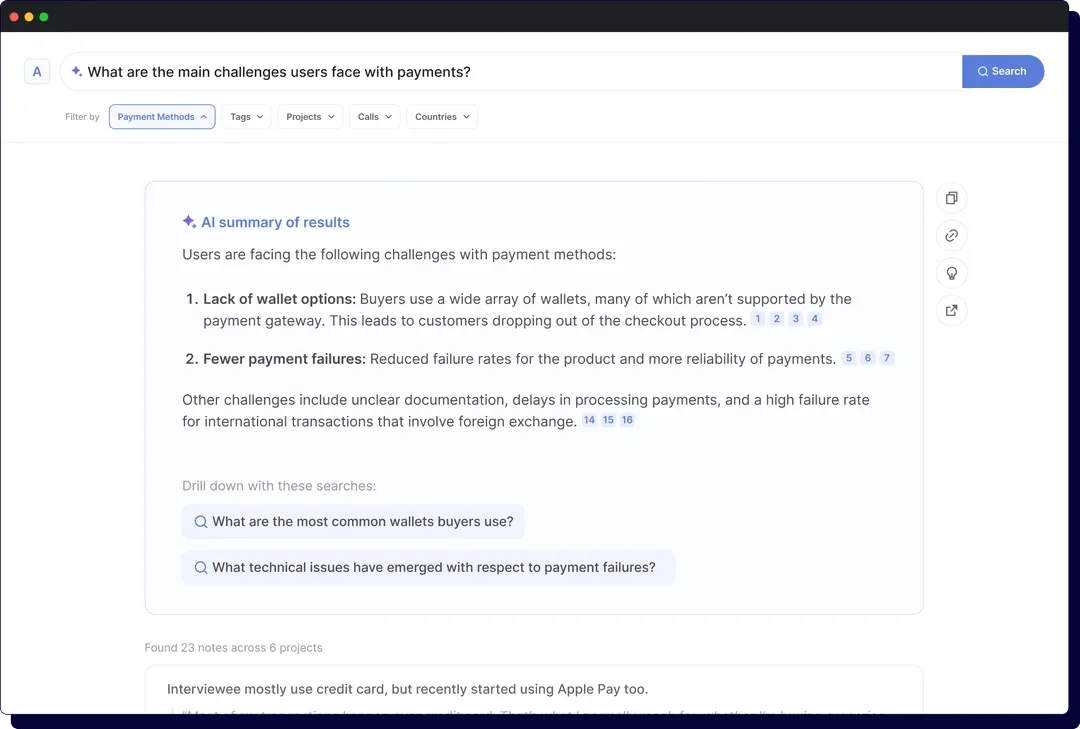
Looppanel is an AI-powered tool tailored for UX researchers. It enables you to do efficient data analysis and organization. This tool comes with features like 90%+ accurate transcripts in minutes, auto-tagging, and smart repository search; it is known to analyze data up to 10x faster. Moreover, it provides you with automated notes that are categorized by research questions, ensuring insights are organized and easy to find. Looppanel's standout feature—its AI-powered tagging system—saves teams from manual work, keeping research accessible and relevant.
How Looppanel helps in UX research
Looppanel accelerates data processing and retrieval, allowing teams to find user insights swiftly.
Standout feature
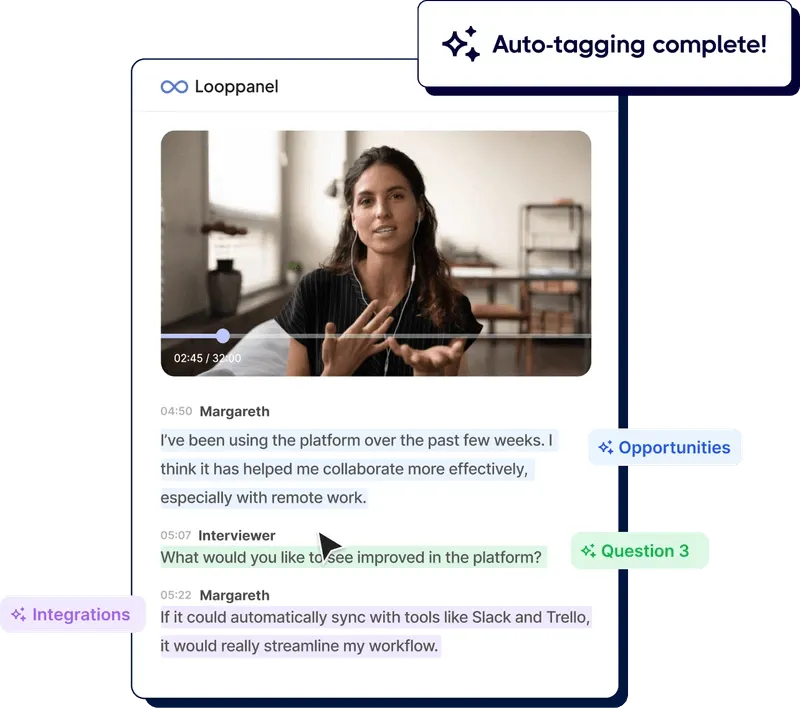
Its AI-powered tagging system saves you from manual work. This keeps research accessible and relevant. For instance, you are conducting user testing sessions for a website redesign. Users provide feedback on various aspects like the homepage layout, navigation bar, and search functionality. In this case, instead of manually going through hours of recordings, Looppanel can help you process the data within minutes. It auto-tags user comments with labels such as “homepage clutter,” “menu confusion,” and “search bar placement.”
Why we ❤️ it:
Looppanel's automation handles tedious tasks. This allows our professionals to focus on deriving insights.
Pricing:
You can avail of its services starting from $27/month.
2. ChatGPT - Best for Quick Ideation and Theme Analysis in UX Research

ChatGPT is an AI-powered tool that offers a versatile, fast approach to UX research support. Although it is not purpose-built for research, it shines in helping UX teams draft survey and interview prompts, brainstorm research questions, and role-play user personas. Moreover, ChatGPT's has the ability to process open-ended responses.
This can help your UX researchers identify themes and synthesize insights. It also aids in generating user stories and ideating solutions based on collected data.
How ChatGPT helps in UX research
ChatGPT streamlines UX research by acting as a reliable assistant for synthesizing user insights and generating actionable ideas. It helps you see patterns in qualitative feedback, organize user pain points, and craft personalized user personas.
Standout feature
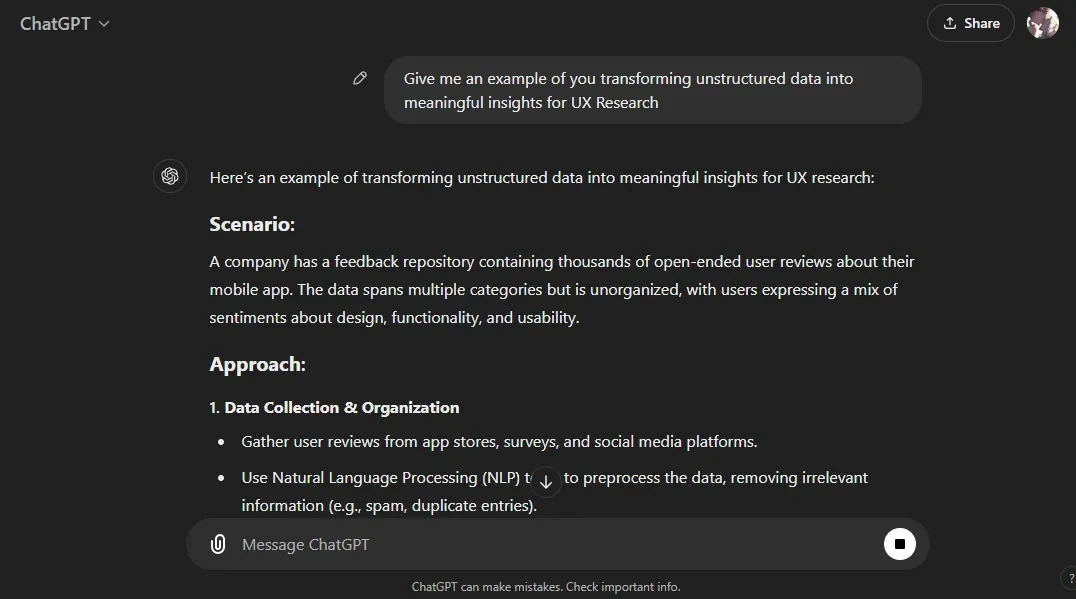
Let's say you are tasked with improving the navigation of a website after conducting user testing. Now, all you have to do is input all user feedback into ChatGPT, including pain points like “menu options are hard to find” or “too many clicks to reach the checkout page.”
Using this input, ChatGPT analyzes the unstructured data and generates a draft sitemap with recommendations:
- Consolidate primary menu items under clear categories such as “Shop,” “Learn,” and “Support.”
- Introduce a search bar prominently in the header.
- Add a shortcut to the checkout page under the cart icon for seamless access.
This ability to transform unstructured data into meaningful insights is invaluable for UX researchers. Moreover, it can identify recurring themes in user responses, helping you prioritize design improvements that resonate with your audience.
Why we ❤️ it:
We like ChatGPT because using it is like having a tireless collaborator for your UX projects. It reduces the time spent on manual data analysis, freeing you to focus on designing impactful solutions..
Pricing:
Youcan access GPT-3.5 for free. However, it also has an enhanced GPT-4 model. To access that, you would be required to pay $20 per month.
3. Maze - Best for Automated Unmoderated UX Testing and Analysis
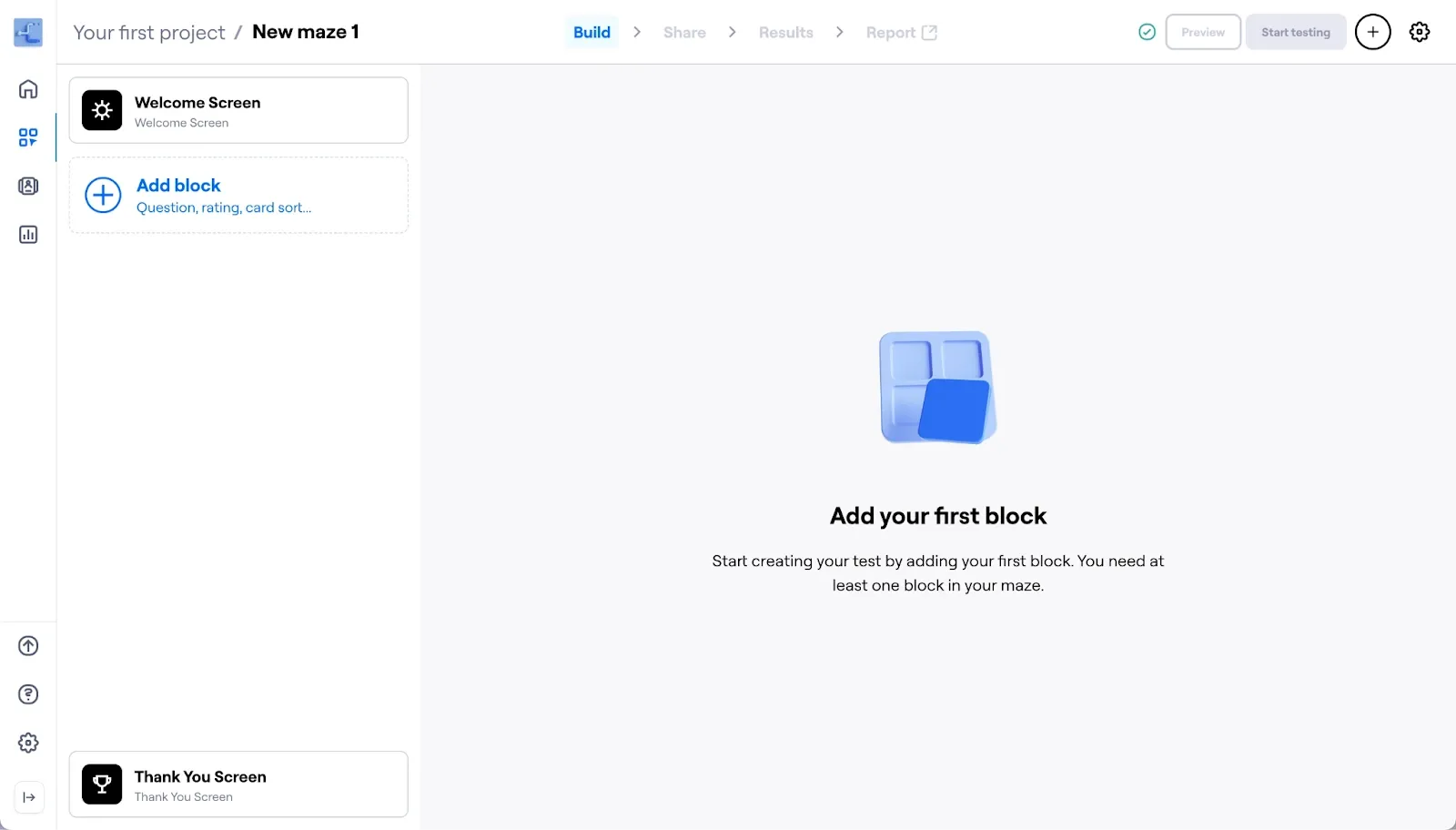
Maze is an AI-driven UX research tool that is designed especially for unmoderated testing. On Maze, you and your researchers can upload prototypes, define user tasks, and rely on AI to analyze interactions. The tool automatically generates reports, including heatmaps and sentiment analysis, giving a clear view of usability and user reactions. This automation saves time by providing actionable insights in minutes, which can be easily shared with your team.
How Maze helps in UX research
Maze's AI analyzes patterns, detects usability issues, and identifies emotional responses without requiring manual moderation.
Standout feature
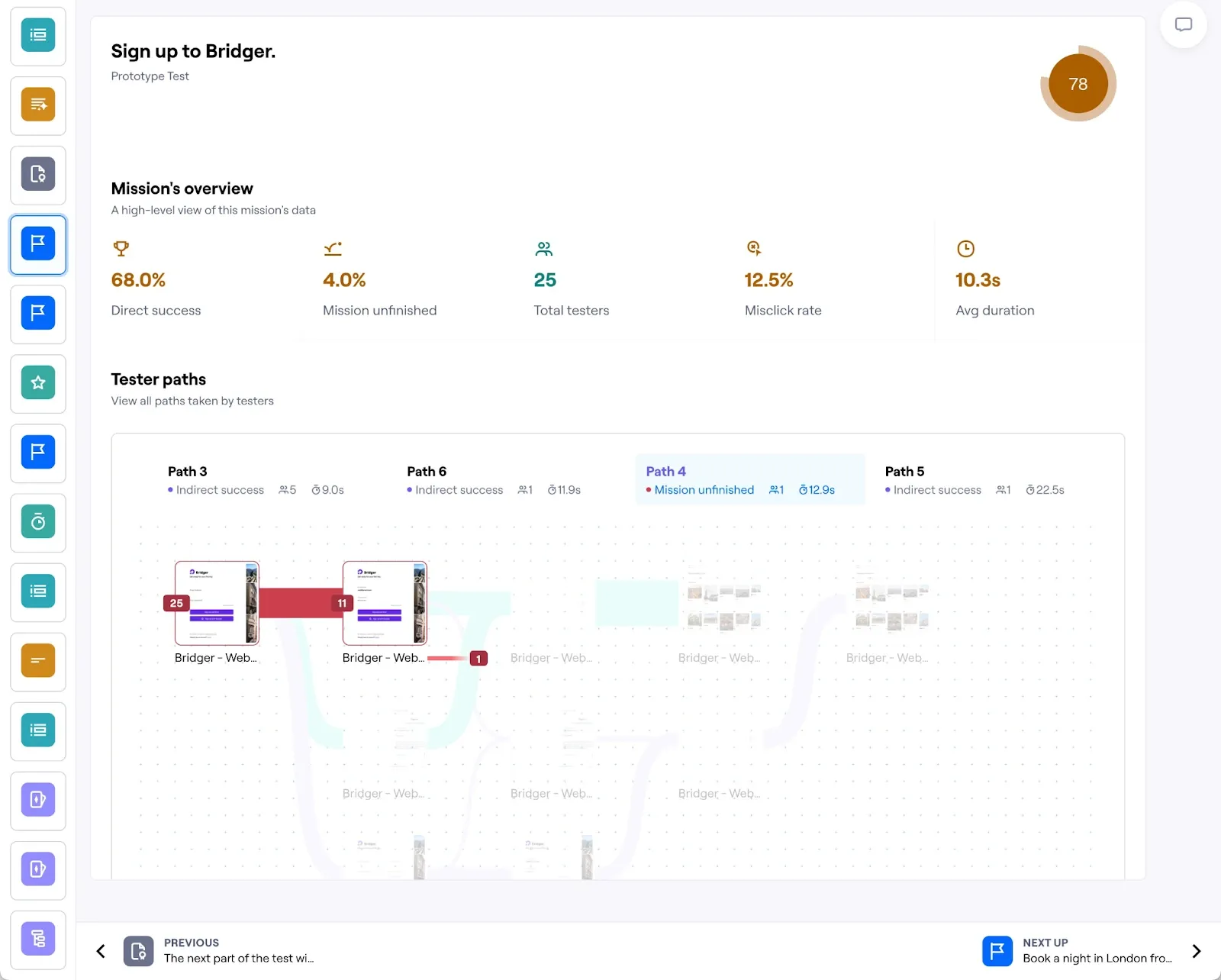
Auto-generated reports with visual insights like heatmaps and sentiment analysis. Let's assume you are conducting a usability test for a newly designed checkout flow in an e-commerce app. Here, Maze can help you create a test where users are asked to complete a purchase. As participants interact with the prototype, Maze will capture data like:
- Click maps to visualize where users are tapping or clicking most frequently.
- Heatmaps show areas of the screen that users engage with the most.
- Sentiment analysis extracted from feedback questions, highlighting how users feel about their experience (e.g., "frustrated," "confused," or "satisfied").
Once the test concludes, Maze generates a comprehensive report with heatmaps highlighting design confusion (e.g., repeated clicks on inactive icons) and click maps identifying friction points.
Why we ❤️ it:
Quick, comprehensive analysis that lets researchers focus on strategy instead of time-consuming manual review.
Pricing:
You do 1 study on Maze each month for free. However, to do more, you would be required to subscribe to its paid plans that start from $99/month.
4. Miro Assist - Best for Streamlining UX Research and Ideation

Miro Assist enhances the popular Miro board with AI-powered tools to simplify and speed up UX research. This AI is integrated directly into Miro. It uses machine learning to generate diagrams, summarize ideas, cluster sticky notes by theme, and create presentation-ready content from research data.
Thus, Miro Assist is considered perfect for researchers who need to make sense of large amounts of qualitative data and filter it into actionable visuals.
How Miro Assist helps in UX research
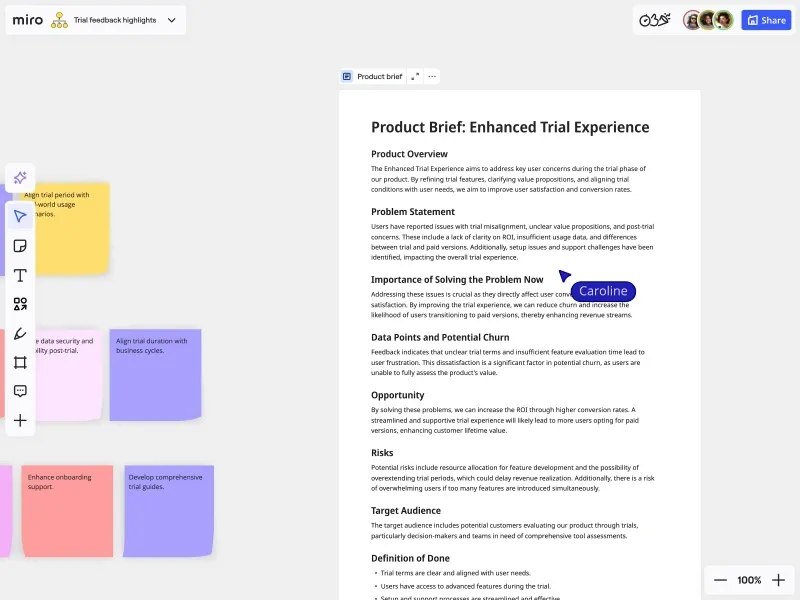
Its cluster analysis for sticky notes groups data by sentiment or keyword. This becomes handy in checking data in a streamlined manner. For instance, after conducting user interviews, a UX researcher can quickly categorize feedback into themes like “positive user experiences” or “frustration points.”
In this case, Miro Assist automatically identifies common keywords or sentiments, reducing manual sorting and ensuring no insight is overlooked. This saves time, enhances accuracy, and allows researchers to focus on extracting valuable insights.
Standout feature
Its cluster analysis for sticky notes groups data by sentiment or keyword. This becomes handy in checking data in a streamlined manner.
Why we ❤️ it:
The thing we love the most about Miro Assist is that it transforms raw brainstorming sessions into structured, actionable outcomes. This helps us save time and make team alignment easier.
Pricing:
Miro Assist is available with all Miro plans: Free, Starter ($8/member per month), Business ($16/member per month), and Enterprise (custom pricing).
5. Dovetail - Best for Streamlined Analysis of Qualitative Data in UX Research
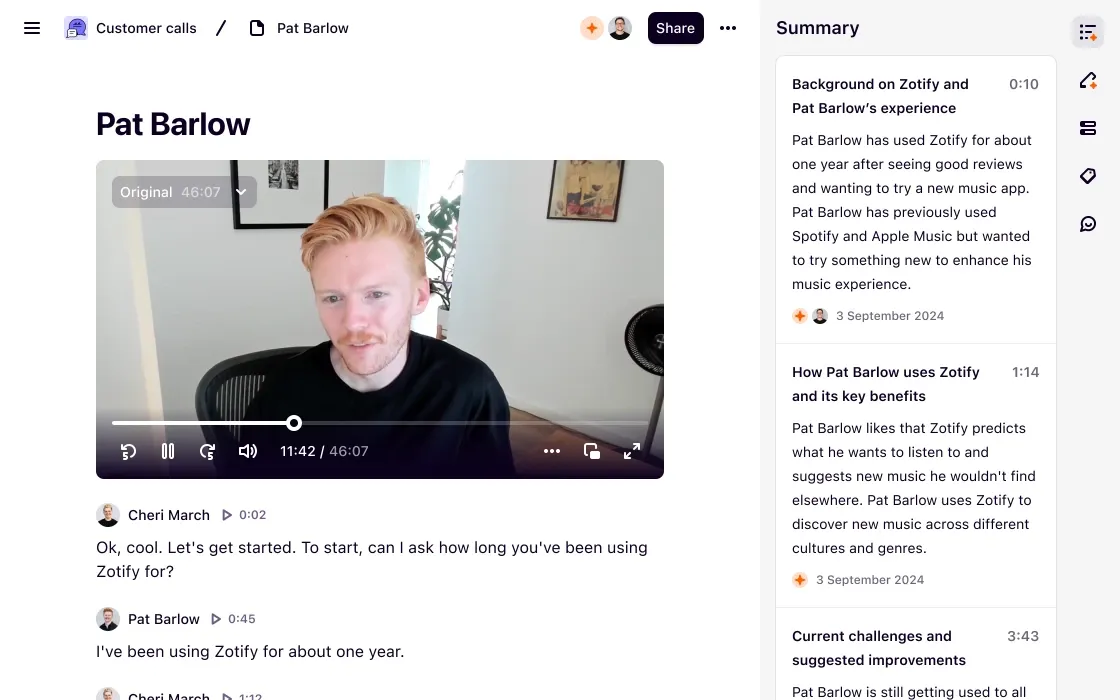
Dovetail is an AI-enhanced platform designed to organize and analyze user research and feedback data. With Dovetail, your team can quickly identify UX patterns and track market sentiment.
In fact, it also helps you organize themes from qualitative data, such as interview transcripts and customer feedback. Apart from this, Dovetail's AI capabilities make it easy to perform thematic clustering and auto-summarization, enabling faster, more insightful UX research.
How Dovetail helps in UX research
It simplifies the analysis of large volumes of qualitative data, allowing teams to uncover user emotions, recurring pain points, and thematic patterns.
Standout feature
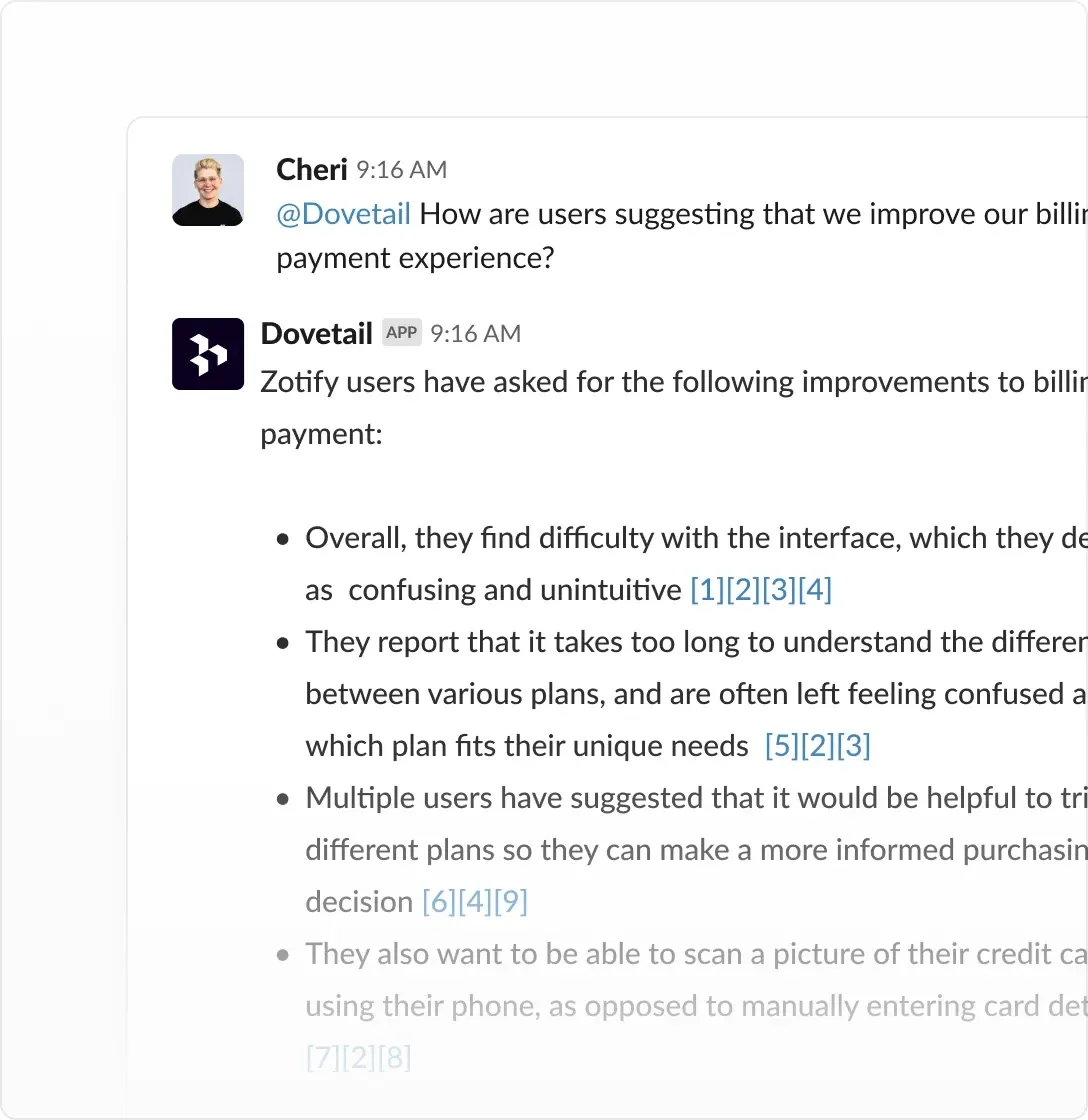
It has thematic clustering groups related insights, generating titles for each theme to help teams identify key trends.
For instance, after analyzing user feedback on a website’s usability, Dovetail might cluster insights under themes like "navigation issues" or "content clarity," helping researchers prioritize areas for improvement. This automatic organization saves time, enhances focus, and ensures that teams can act on the most significant findings without manual sorting.
Why we ❤️ it:
Dovetail's AI tools transform complex, text-heavy data into organized, actionable insights. This helps us enhance collaboration and make UX research more effective.
Pricing:
Dovetail offers free trials. However, for continuous usage, you would have to subscribe to one of their paid plans. Their plans start at $30 per month (Starter), with advanced options at $375/month (Team) and $1,800/month (Business).
6. Notably - Best for Effortless Summarization and Sentiment Analysis in UX Research
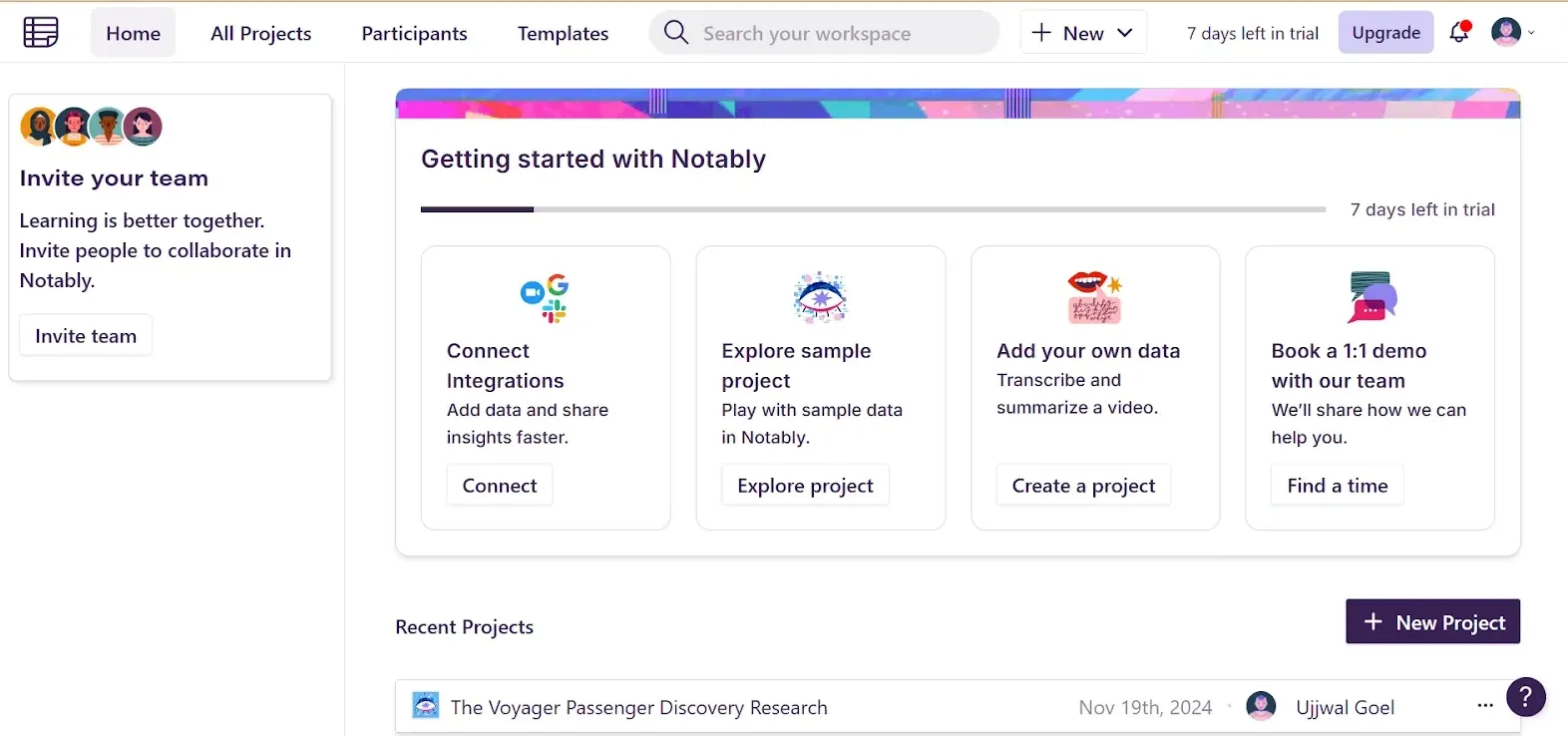
Notably is an AI-driven user research platform known for simplifying the analysis of qualitative data with powerful tools. Some of the tools it uses are video transcription, cluster analysis, and digital sticky notes. This tool helps you generate concise summaries, perform sentiment analysis, and auto-highlight essential insights. Such functions allow researchers to uncover patterns and emotions quickly without manual work.
How Notably helps in UX research
Notably speeds up the analysis process by providing instant summaries of interview data and auto-clustering themes. This helps UX teams identify patterns, user sentiments, and actionable insights quickly.
Standout feature

Notably’s sentiment analysis gives an instant overview of participant attitudes. This makes it easy to measure positive, negative, and neutral sentiments across studies.
For example, if users express frustration with a feature, the tool will highlight these sentiments. This analysis is especially useful across multiple studies, enabling researchers to identify recurring patterns and trends in user feedback without manually combing through data.
Why we ❤️ it:
Notably eliminates the manual work associated with user research, freeing up time for our experts for deeper analysis and creative insights. Moreover, we also find the platform’s ability to generate images from data insights to be handy in reading research reports.
Pricing:
You can use Notably for $40 per month (Pro plan). However, its team plan is available at $300 per month. There is also an option to get custom pricing, for which you would have to connect with their team.
7. QoQo (Figma Plugin) - Best for Figma-Based UX Research Enhancement
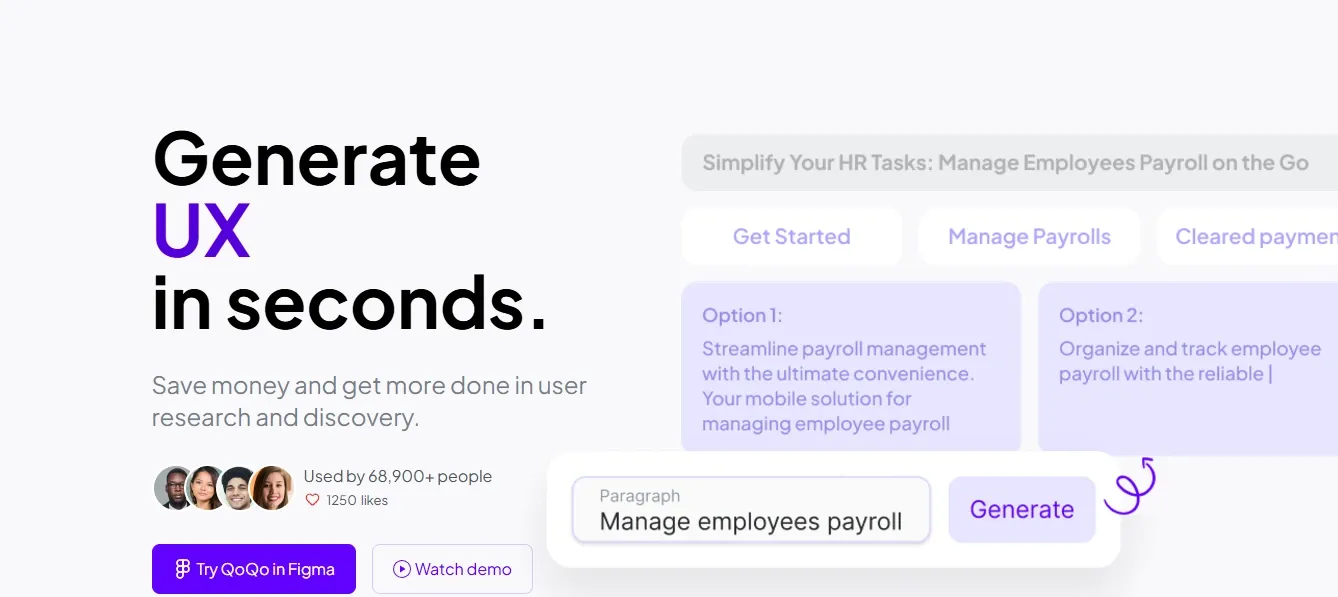
QoQo is an AI-powered Figma plugin that uses OpenAI’s GPT technology to streamline user research activities directly within Figma. This universal tool supports creating user journey maps, affinity diagrams, and interview scripts.
QoQo helps generate all this quickly to keep design teams focused on the user experience. Apart from this, QoQo enhances the UX workflow with ease and precision by assisting in building accurate user personas and organizing dense research data.
How QoQo (Figma Plugin) helps in UX research
QoQo allows UX researchers to visualize user journeys, gain insights from group research, and generate structured personas. In addition, all this is done within Figma’s familiar interface.
Standout feature
The ability of this tool to auto-generate affinity diagrams from complex data is a very distinguished feature. This saves hours of manual sorting.
For instance, if a UX researcher has gathered diverse insights about an app's onboarding process, QoQo will automatically group feedback into themes. These themes can be "ease of use," "visual design," and "instructions clarity." Such automatic sorting saves hours of manual work, allowing researchers to quickly visualize trends and focus on actionable insights.
Why we ❤️ it:
Integrating QoQo with Figma makes it a seamless research asset. This has accelerated insight generation for us while supporting a cohesive design process.
Pricing:
QoQo offers unlimited access for just $4 per month.
8. Sprig - Best for Real-Time User Feedback and Analysis
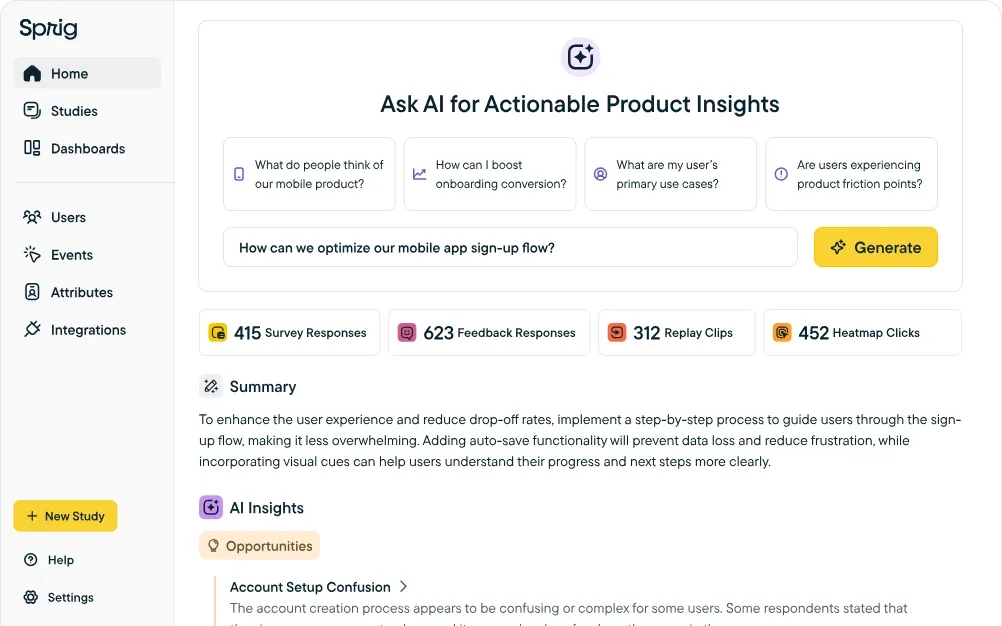
Sprig is an AI-powered micro-survey tool designed to gather in-app user feedback. It has AI features like sentiment detection, emotion analysis, and keyword extraction that automate the review process for open-ended survey responses. This allows you to focus on strategy over data parsing. Moreover, this tool excels at collecting real-time insights directly from users, enhancing your UX research and helping you pinpoint key issues.
How Sprig helps in UX research
Sprig simplifies user feedback by automating analysis, enabling quick identification of trends and sentiments.
Standout feature
Sprig’s standout feature is its AI-driven sentiment and emotion detection, which turns raw user feedback into actionable insights. UX researchers can upload text data from surveys, interviews, or product reviews, and Sprig’s AI analyzes the tone, sentiment, and emotional context behind the responses.
For example, if users express frustration with a checkout process, Sprig can identify negative emotions like “anger” or “disappointment” and categorize them accordingly. This allows researchers to pinpoint specific pain points, prioritize issues, and personalize solutions.
Why we ❤️ it:
We love Sprig because it makes real-time feedback collection effortless and provides insightful summaries. This is perfect for fast-paced design cycles.
Pricing:
There is a free plan available for using Sprig. However, to get enhanced solutions, its paid plans start at $175/month.
9. Synthetic Users - Best for Scaling User Testing with AI Simulations
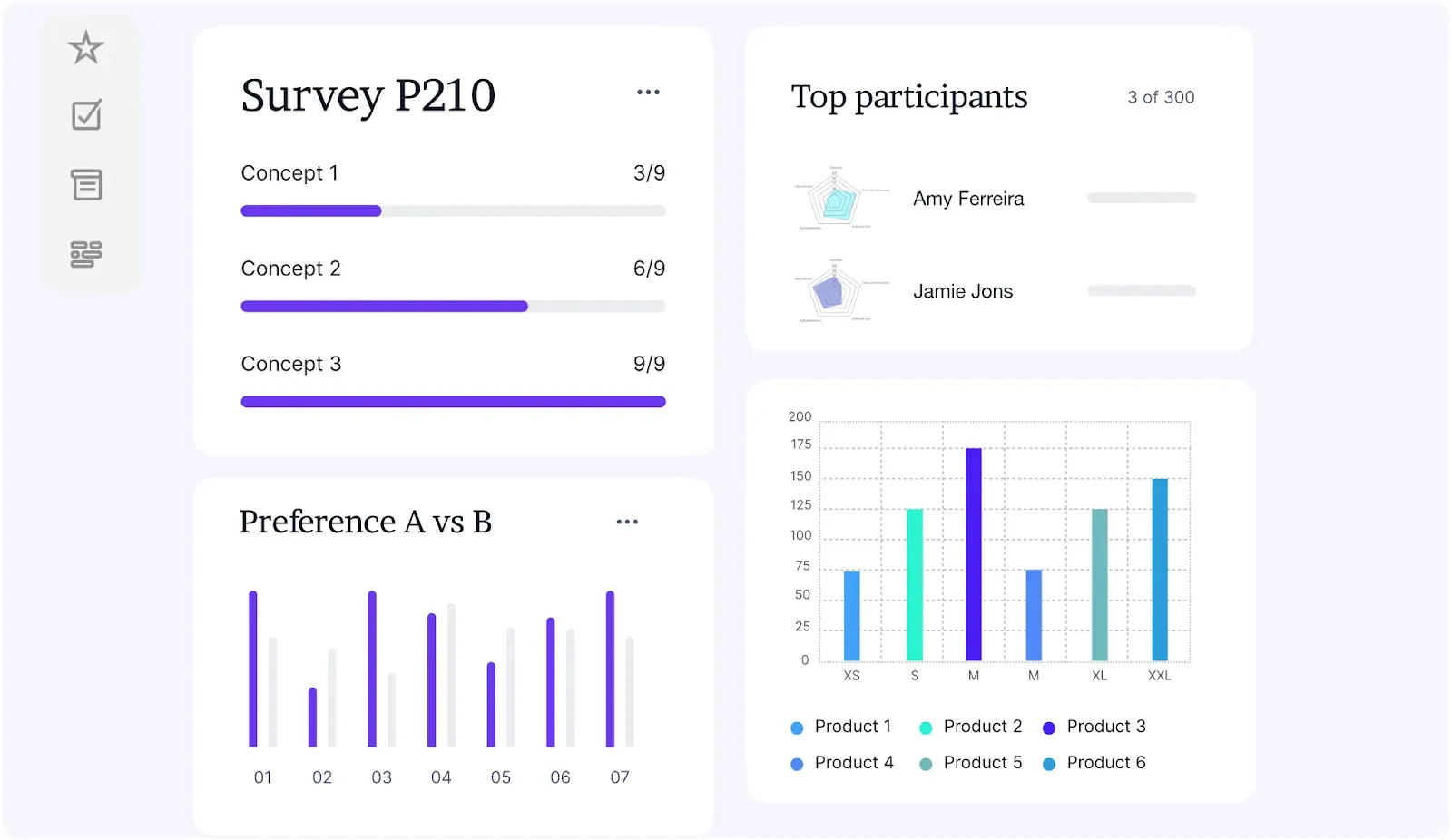
Synthetic Users is a tool that uses AI to create virtual user-profiles and simulate interactions. This allows UX experts to test designs and gather feedback without recruiting real participants. Moreover, Synthetic Users generates realistic user personas and behaviors, providing scalable feedback that mimics what real users might do. This makes it ideal for teams looking to validate designs efficiently and conduct large-scale testing without the hassle of traditional recruitment.
How Synthetic Users helps in UX Research
It enables extensive usability testing and feedback collection with fewer logistical demands by using simulated users.
Standout feature
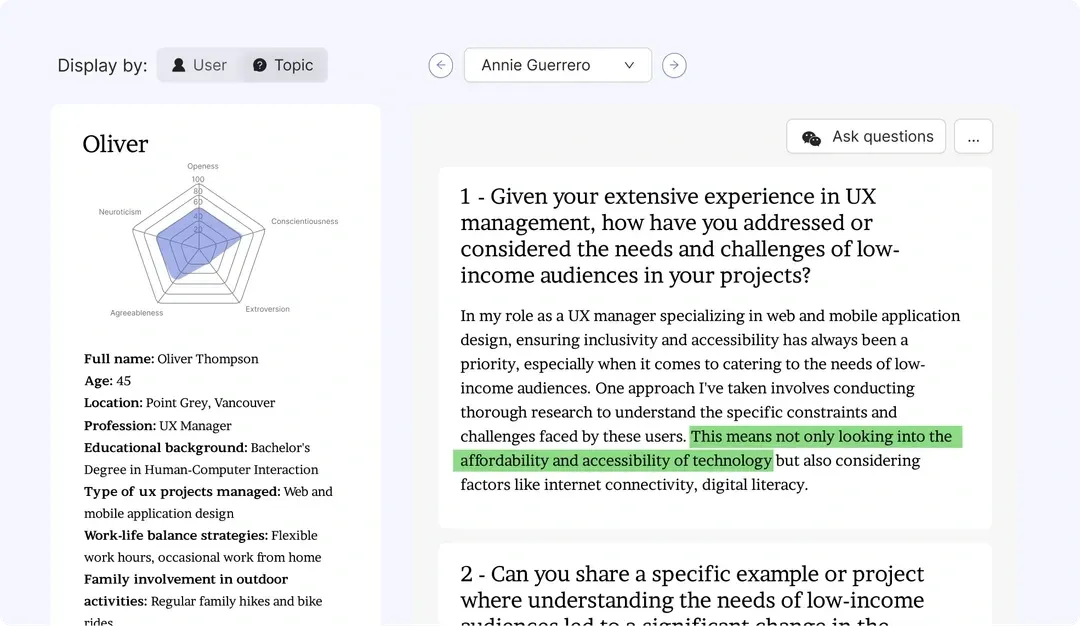
Synthetic Users have AI-driven user behavior simulation. It offers insights into user interactions at scale.
For example, a researcher could simulate how user activities on a website with Synthetic Users, identifying friction points such as unclear buttons or slow-loading pages. With the help of this data, they can refine the website's design for better usability and conversion rates.
Why we ❤️ it:
Synthetic Users tackles the recruitment challenge head-on. This makes rapid and scalable testing possible while still providing meaningful insights.
Pricing:
You can avail of Synthetic Users starting from $99/month.
10. Perplexity.ai - Best for Quick Research Discovery and Context Gathering
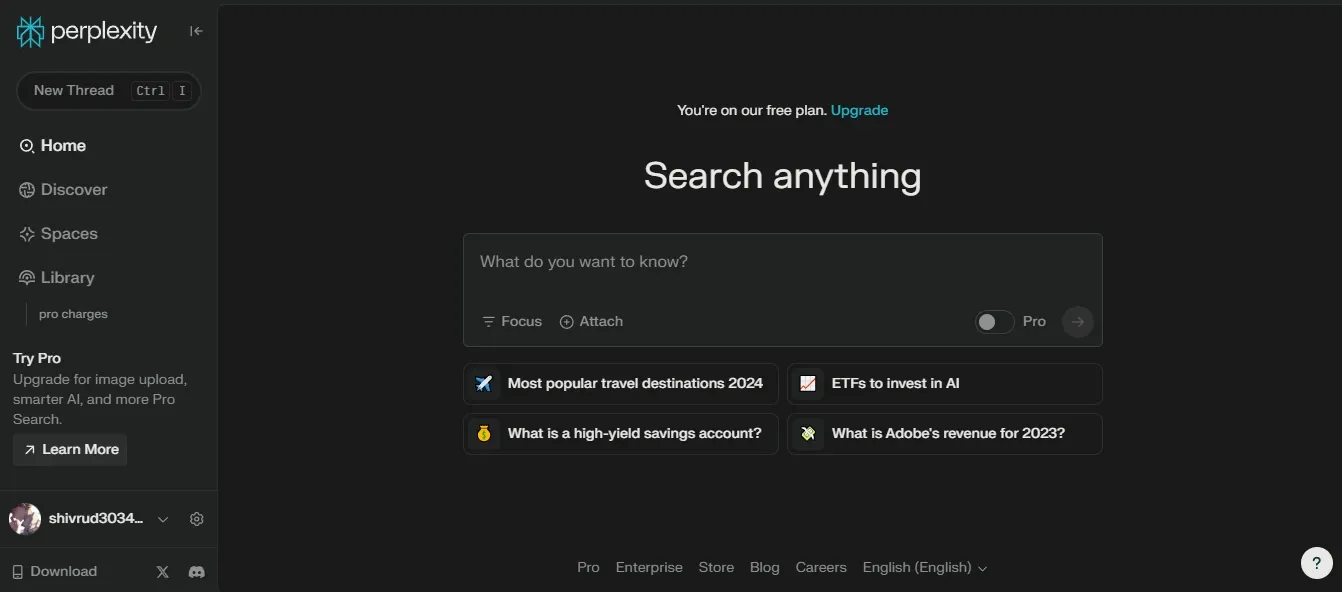
Perplexity.ai is an AI-powered search tool that streamlines the process of finding relevant information, studies, and data. It delivers detailed answers alongside source citations for each claim by acting like a fusion of Google and ChatGPT. This makes it easier to verify information and assess credibility. Thus, Perplexity.ai is considered an invaluable tool for UX researchers needing fast, reliable insights and context on specific topics.
How Perplexity.ai helps in UX research
It accelerates the research phase by quickly surfacing credible sources. This helps researchers gain insights and context efficiently.
Standout feature
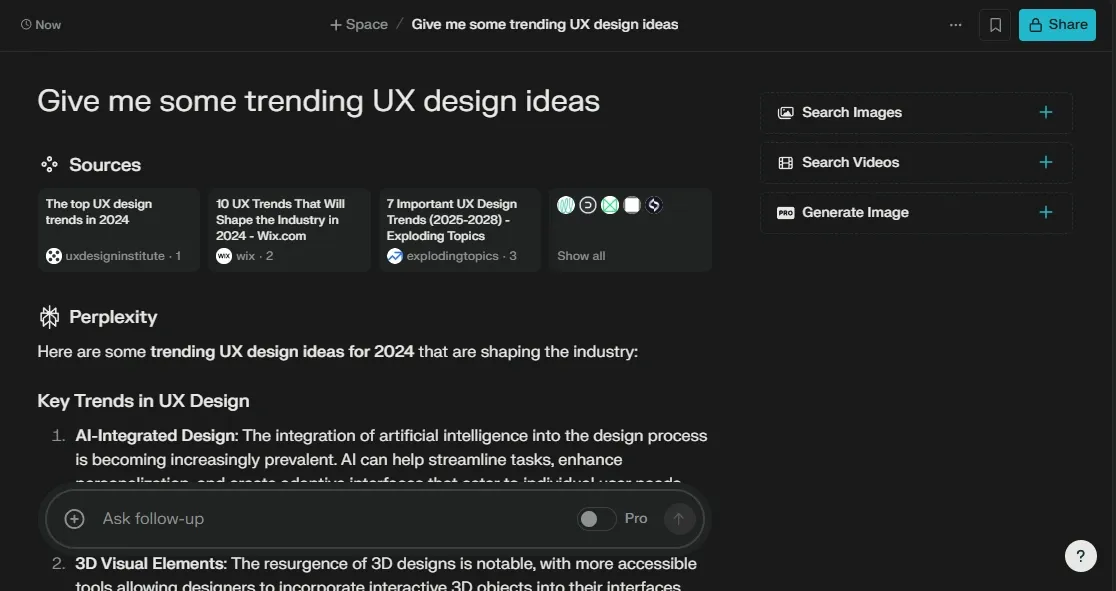
Perplexity.ai provides auto-generated answers with source citations. This makes it a tool that offers reliable information in every search result.
Let’s say your UX team asks Perplexity.ai a couple of queries or statistics related to web design. This tool will then auto-generate an answer by searching for the relevant data across the web. Moreover, it also lists the references it used to formulate that particular answer, ensuring everything is credible and research-backed.
Why we ❤️ it:
Our team loves Perplexity.ai because it combines speed with reliability, letting us locate well-sourced information faster than traditional searches.
Pricing:
It is free to use. However, Perplexity.ai also offers a Pro plan, which is available for $20/month.
Can AI do UX research?
AI tools have introduced new possibilities in UX research by automating data collection and processing user behavior insights. In fact, it now even predicts design needs based on trends and analytics.
Moreover, they can handle vast datasets quickly. This helps identify patterns that inform decisions on user interface, content layout, and engagement strategies. Thus, AI-powered tools are considered excellent for tracking quantitative metrics and offering initial insights, making the UX research process more efficient.
However, AI still has limitations. It lacks the understanding of human emotions, behaviors, and motivations. These are critical factors in creating truly empathetic, user-centered designs. Moreover, AI cannot fully grasp context and cultural subtleties or anticipate unique human responses to design elements.
Can UX be replaced by AI?
Not entirely—AI enhances UX, but the expertise of professional UX researchers and designers remains essential. These skilled professionals bring a depth of empathy and creativity, ensuring designs are both effective and meaningful for users. This is where Tenet can help, blending technology with human insight to deliver exceptional UX.
How Tenet helps you in UX research and design
At Tenet, we believe exceptional UX design drives growth, user loyalty, and revenue. Our structured process guides clients from onboarding to delivery, clearly explaining each phase's purpose.
We fill knowledge gaps by offering insights beyond UX, covering areas like email marketing and SEO, which has made us a trusted partner for brands like Gartner.
Clients can visualize their products through mockups and prototypes, and we provide post-launch support to adapt designs as needed.
With transparent pricing and full ownership of deliverables, we ensure clients know exactly what to expect throughout the process.
Still unsure? Take a peek at how we helped our client. To see our past work, check out our portfolio of UX research and design.
Final Words
AI tools for UX research offer a powerful way to enhance and streamline the design process. They have proven to be handy in giving insights that fuel better user experiences. However, it is important to keep in mind that AI is just an assistant that will help you in your research. They are most impactful when paired with the expertise of seasoned UX professionals. So, ensure you rely on a competent team of experts who value your vision and understand the essence of your business and target market.

Alisha P.
Alisha is a skilled UI UX Designer at Tenet, a Dubai-based UI UX design and growth marketing agency. With a passion for creating intuitive and user-friendly digital experiences, Alisha plays a pivotal role in crafting designs that align with user needs and business goals. Her expertise encompasses user research, wireframing, prototyping, and usability testing, ensuring that each project delivers a seamless and engaging user journey.

Got an idea on your mind?
We’d love to hear about your brand, your visions, current challenges, even if you’re not sure what your next step is.
Let’s talk







 U.A.E:
U.A.E: India:
India: UK:
UK: USA:
USA:
